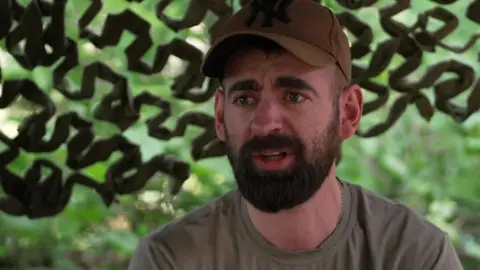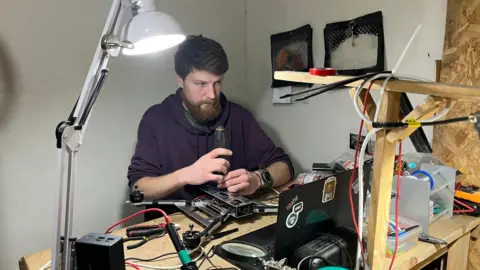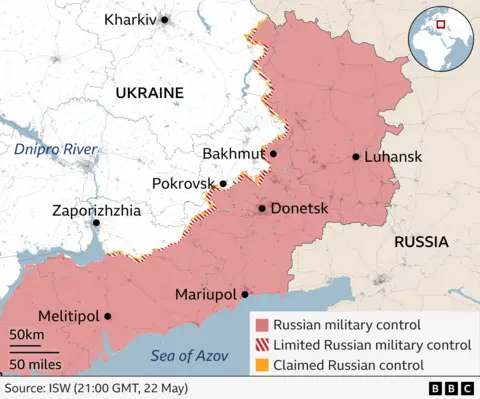The terrifying new weapon changing the war in Ukraine
An acrid smell hangs over the town of Rodynske. A couple of minutes after we drive into the city we see where it's coming from.
A 250kg glide bomb has ripped through the town's main administrative building, and taken down three residential blocks. We're visiting a day after the bomb struck, but parts of the wreckage are still smoking. From the edges of the town we hear the sound of artillery fire, and of gunshots – Ukrainian soldiers shooting down drones.
Rodynske is about 15km (9 miles) north of the embattled city of Pokrovsk. Russia has been trying to capture it from the south since the autumn of last year, but Ukrainian forces have so far managed to stop Russian soldiers from marching in.
So Russia has changed tactics, moving instead to encircle the city, cutting off supply routes.
In the past two weeks, as hectic diplomatic efforts to bring about a ceasefire in Ukraine have failed, Russia has intensified its push, making its most significant advances since January.
We find proof of that in Rodynske.
Within minutes of us arriving in town, we hear a Russian drone above us. Our team runs to the closest cover available – a tree.
 Getty Images
Getty ImagesWe press up against it so the drone won't see us. Then there's the sound of a loud explosion – it's a second drone making impact nearby. The drone above us is still hovering. For a few more minutes, we hear the terrifying whirring sound of what's become the deadliest weapon of this war.
When we can't hear it any more we take the chance to run to hard cover in an abandoned building 100ft away.
From the shelter, we hear the drone again. It's possible it returned after seeing our movement.
That Rodynske is being swarmed by Russian drones is evidence that the attacks are coming from positions much closer than known Russian positions to the south of Pokrovsk. They were most likely coming from newly captured territory on a key road running from the east of Pokrovsk to Kostyantynivka.
After half an hour of waiting in the shelter, when we can't hear the drone anymore, we move quickly to our car parked under tree cover, and speed out of Rodynske. By the side of the highway we see smoke billowing and something burning – it's most likely a downed drone.

We drive to Bilytske, further away from the frontline. We see a row of houses destroyed by a missile strike overnight. One of them was Svitlana's home.
"It's getting worse and worse. Earlier, we could hear distant explosions, they were far away. But now our town is getting targeted – we're experiencing it ourselves," says the 61-year-old, as she picks up a few belongings from the wreckage of her home. Luckily Svitlana wasn't at home when the attack occurred.
"Go into the centre of the town, you'll see so much that is destroyed there. And the bakery and zoo have been destroyed too," she says.
At a safehouse just out of reach of drones, we meet soldiers of the artillery unit of the 5th Assault Brigade.
"You can feel the intensity of Russian assaults increasing. Rockets, mortars, drones, they're using everything they have to cut off supply routes going into the city," says Serhii.
His unit has been waiting for three days to deploy to their positions, waiting for cloud cover or high-speed winds to give them protection from drones.

In an ever-evolving conflict, soldiers have had to rapidly adapt to new threats posed by changing technology. And the latest threat comes from fibre optic drones. A spool of tens of kilometres of cable is fitted to the bottom of a drone and the physical fibre optic cord is attached to the controller held by the pilot.
"The video and control signal is transmitted to and from the drone through the cable, not through radio frequencies. This means it can't be jammed by electronic interceptors," says a soldier with the call sign Moderator, a drone engineer with the 68th Jaeger Brigade.
When drones began to be used in this war in a big way, both militaries fitted their vehicles with electronic warfare systems, which could neutralise drones. That protection has evaporated with the arrival of fibre optic drones, and in the deployment of these devices, Russia currently has the edge. Ukraine is trying to ramp up production.
"Russia started using fibre optic drones much before us, while we were still testing them. These drones can be used in places where we have to go lower than usual drones. We can even enter houses and look for targets inside," says Venia, a drone pilot with the 68th Jaeger Brigade.
"We've started joking that maybe we should carry scissors to cut the cord," says Serhii, the artillery man.
Fibre optic drones do have drawbacks – they are slower and the cable could get entangled in trees. But at the moment, their widespread use by Russia means that transporting soldiers to and from their positions can often be deadlier than the battlefield itself.

"When you enter a position, you don't know whether you've been spotted or not. And if you have been spotted, then you may already be living the last hours of your life," says Oles, Chief Sergeant of the reconnaissance unit of the 5th Assault Brigade.
This threat means that soldiers are spending longer and longer in their positions.
Oles and his men are in the infantry, serving in the trenches right at the very front of Ukraine's defence. It's rare for journalists these days to speak to infantrymen, as it's become too risky to go to these trenches. We meet Oles and Maksym in a rural home converted into a makeshift base, where the soldiers come to rest when they're not on deployment.
"The longest I spent at the position was 31 days, but I do know guys who have spent 90 and even 120 days there. Back before the drones arrived, the rotations could have been between 3 or 7 days at the position," says Maksym.
"War is blood, death, wet mud and a chill that spreads from head to toe. And this is how you spend every day. I remember one instance when we didn't sleep for three days, alert every minute. The Russians kept coming at us wave after wave. Even a minor lapse would have meant we were dead."
Oles says Russia's infantry has changed its tactics. "Earlier they attacked in groups. Now they only send one or two people at times. They also use motorcycles and in a few instances, quad bikes. Sometimes they slip through."
What this means is that the front lines in some parts are no longer conventional lines with the Ukrainians on one side and the Russians on the other, but more like pieces on a chessboard during play, where positions can be intertwined.
This also makes it harder to see advances made by either side.

Despite Russia's recent gains, it will not be quick or easy for it to take the whole of the Donetsk region, where Pokrovsk lies.
Ukraine has pushed back hard, but it needs a steady supply of weapons and ammunition to sustain the fight.
And as the war enters a fourth summer, Ukraine's manpower issues against a much bigger Russian army are also evident. Most of the soldiers we meet joined the military after the war began. They've had a few months of training, but have had to learn a lot on the job in the middle of a raging war.
Maksym worked for a drinks company before he joined the military. I asked how his family copes with his job.
"It's hard, it's really hard. My family really supports me. But I have a two-year-old son, and I don't get to see him much. I do video call him though, so everything is as fine as it could be under the circumstances," he trails off, eyes welling up with tears.
Maksym is a soldier fighting for his country, but he's also just a father missing his two-year-old boy.
Additional reporting by Imogen Anderson, Sanjay Ganguly, Volodymyr Lozhko and Anastasiia Levchenko
